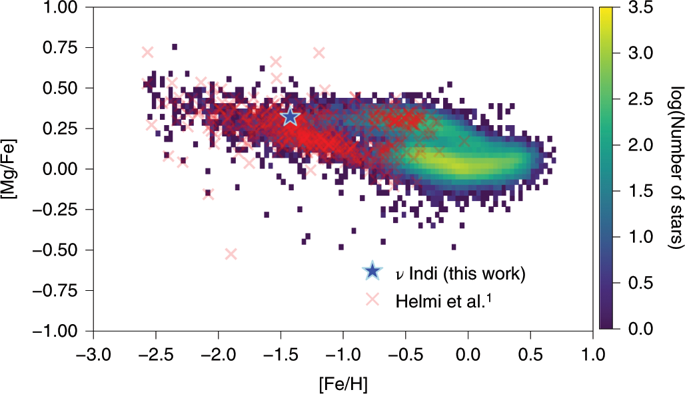Nature Astronomy ( IF 12.9 ) Pub Date : 2020-01-13 , DOI: 10.1038/s41550-019-0975-9 William J. Chaplin , Aldo M. Serenelli , Andrea Miglio , Thierry Morel , J. Ted Mackereth , Fiorenzo Vincenzo , Hans Kjeldsen , Sarbani Basu , Warrick H. Ball , Amalie Stokholm , Kuldeep Verma , Jakob Rørsted Mosumgaard , Victor Silva Aguirre , Anwesh Mazumdar , Pritesh Ranadive , H. M. Antia , Yveline Lebreton , Joel Ong , Thierry Appourchaux , Timothy R. Bedding , Jørgen Christensen-Dalsgaard , Orlagh Creevey , Rafael A. García , Rasmus Handberg , Daniel Huber , Steven D. Kawaler , Mikkel N. Lund , Travis S. Metcalfe , Keivan G. Stassun , Michäel Bazot , Paul G. Beck , Keaton J. Bell , Maria Bergemann , Derek L. Buzasi , Othman Benomar , Diego Bossini , Lisa Bugnet , Tiago L. Campante , Zeynep Çelik Orhan , Enrico Corsaro , Lucía González-Cuesta , Guy R. Davies , Maria Pia Di Mauro , Ricky Egeland , Yvonne P. Elsworth , Patrick Gaulme , Hamed Ghasemi , Zhao Guo , Oliver J. Hall , Amir Hasanzadeh , Saskia Hekker , Rachel Howe , Jon M. Jenkins , Antonio Jiménez , René Kiefer , James S. Kuszlewicz , Thomas Kallinger , David W. Latham , Mia S. Lundkvist , Savita Mathur , Josefina Montalbán , Benoit Mosser , Andres Moya Bedón , Martin Bo Nielsen , Sibel Örtel , Ben M. Rendle , George R. Ricker , Thaíse S. Rodrigues , Ian W. Roxburgh , Hossein Safari , Mathew Schofield , Sara Seager , Barry Smalley , Dennis Stello , Róbert Szabó , Jamie Tayar , Nathalie Themeßl , Alexandra E. L. Thomas , Roland K. Vanderspek , Walter E. van Rossem , Mathieu Vrard , Achim Weiss , Timothy R. White , Joshua N. Winn , Mutlu Yıldız

|
Over the course of its history, the Milky Way has ingested multiple smaller satellite galaxies1. Although these accreted stellar populations can be forensically identified as kinematically distinct structures within the Galaxy, it is difficult in general to date precisely the age at which any one merger occurred. Recent results have revealed a population of stars that were accreted via the collision of a dwarf galaxy, called Gaia–Enceladus1, leading to substantial pollution of the chemical and dynamical properties of the Milky Way. Here we identify the very bright, naked-eye star ν Indi as an indicator of the age of the early in situ population of the Galaxy. We combine asteroseismic, spectroscopic, astrometric and kinematic observations to show that this metal-poor, alpha-element-rich star was an indigenous member of the halo, and we measure its age to be \(11.0\pm 0.7\) (stat) \(\pm 0.8\) (sys) billion years. The star bears hallmarks consistent with having been kinematically heated by the Gaia–Enceladus collision. Its age implies that the earliest the merger could have begun was 11.6 and 13.2 billion years ago, at 68% and 95% confidence, respectively. Computations based on hierarchical cosmological models slightly reduce the above limits.
中文翻译:

通过裸眼恒星 ν Indi 的星震学确定早期银河系合并的年龄
在其历史进程中,银河系吞噬了多个较小的卫星星系1。尽管这些吸积的恒星群体可以通过法医鉴定为银河系中运动学上不同的结构,但通常很难准确确定任何一次合并发生的年龄。最近的结果揭示了一群恒星是通过矮星系的碰撞吸积而成的,称为盖亚-土卫二1,导致银河系的化学和动力学特性受到严重污染。在这里,我们将非常明亮的肉眼恒星ν Indi 确定为银河系早期原地人口年龄的指标。我们结合了星震、光谱、天体测量和运动学观测,表明这颗金属贫乏、富含 α 元素的恒星是光晕的土著成员,我们测量它的年龄为\(11.0\pm 0.7\) (stat) \(\pm 0.8\)(sys) 亿年。这颗恒星具有与盖亚-土卫二碰撞运动学加热一致的特征。它的年龄意味着合并最早可能开始于 11.6 和 132 亿年前,置信度分别为 68% 和 95%。基于分层宇宙学模型的计算略微降低了上述限制。











































 京公网安备 11010802027423号
京公网安备 11010802027423号